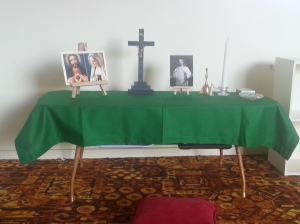“I did Level 1, Part 1 of the Catechesis of the Good Shepherd in early 2023. It was an amazing experience that has enriched my faith and has now become a way to pass on our faith to the next generation. I would recommend it to anyone keen on helping youngsters find their spirituality and meditative space in the Lord.”
A parishioner and grandmother
“Being part of the formation training has impacted my classroom RE teaching and learning in subtle but powerful ways. It helped me to see how going slower and deeper impacts on children’s understanding. I really appreciated the engagement and richness of the “hand-on” aspect of Atrium and have blended this into my teaching. Within my classroom I have set up a mini Atrium which the children (2 at a time) use as a calm, reflective space. Formation also helped me gain further understanding and knowledge of Catholic liturgical practices.”
A teacher in a Catholic school
“Picture your very own Monastery…but one that children can go to. Where the Holy Spirit works, guides, loves and teaches through the many presentations of the CGS. You will enjoy learning more about your Catholic Faith and be inspired to grow your own relationship with God alongside the many children you will meet through this work.
“I have the privilege of journeying alongside children at a Catholic Primary School and am constantly touched and amazed with how The Holy Spirit touches the hearts of these children and mine as well.
“The CGS will equip you with the knowledge you need to deliver presentations so that you will have the confidence to put everything into practice…and over time it will come naturally to you. Furthermore, you will have ongoing support.”
A volunteer in a school atrium
“Going for the formation has changed the trajectory of my faith as a young person. It has deepened my relationship with God, as the course fully covers the theology behind the catechism. The theory within it, is complemented by the practical aspect, by showing the presentation and linking it back to the teaching. This is a course that cannot be missed and will bring your faith to a different perspective. This is something that cannot be missed.”
A uni student
“I feel so blessed to attend the formation course level 1 of the Catechesis of the Good Shepherd in early this year.
“To be honest I just feel like a child going to the Atrium rather than attending a training to become a catechist. I really enjoyed the presentations. They touched deep inside my heart.
“I also find making materials was also very useful. I love it.
“The leaders and the supporting team are very enthusiastic and helpful. The course was well organised. I like how the albums pages were assigned to each group and checked by the trainers so by the end of the course we could be able to complete all the album pages.
“Overall, I had a great experience attending this course.“
A mum and Montessorian
“The formation course was the start of a journey I truly wasn’t expecting. It was a clear call to action that rocked me to the core. In the Atrium, our children’s stillness and soulful connection with God is awe-some.”
A parishioner interested in CG
“My name is Coradel, I am Catholic by birth.
“The CGS level one course had deepened my understanding about my faith. I was able to experience the gift of the Montessori way of teaching children about our Catholic faith. The Education to wonder is my favourite part because it is limitless and very powerful when reading the Bible and living our everyday life.“
A parishioner and mother
“The course was of course very helpful in working with the children in the atrium, but it was also good for my own faith and life outside of the atrium as well. In the world with the internet at our fingertips we don’t often take the time to wonder, we can easily find answers to things we want to know. This formation helps you step away from that, to reflect, to learn to ponder God’s mysteries and to share that with others. It made me realise it’s good to not have all the answers, it’s good that God doesn’t tell us everything about himself, the joy of discovery and wonder are great gifts to us. It has helped me as an adult to ponder and explore, affecting the way I view the world around me, and the way I share my faith with others, both children and adults.”
An assistant in an atrium
“I first attended CGS formation 9 years ago and was blown away from the first presentation. CGS not only presents the essentials of the faith to children in a way they can grasp, it helps us adults become more childlike in our faith and encounter God in a new, deeper way. Having seen how CGS has impacted my children and the other children I work with in the atrium, I believe everyone in any way connected with Catholic children should attend CGS formation so they can understand and support their religious needs more fully.”
A CGS catechist
































